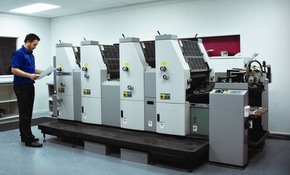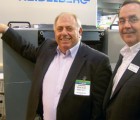

Hybrid printing describes presses that apply at least two printing technologies in a single system, or a single printed product that uses at least two printing processes. Most direct mail is printed offset as shells and then run through toner or inkjet printers for some level of personalisation. Hybrid printing makes this a one-step process.
Hybrid configurations with gravure and flexographic printing are common. Flexo systems have had gravure cylinders inline for coating; as well as inkjet modules EFI Jetrion, for example, for variable-data printing.
Inkjet may be integrated on press and this generally involves the use of one or more inkjet heads mounted on a web-fed offset press, although it is now common for inkjet to be used in conjunction with a sheetfed offset press.
One or more inkjet heads may also be mounted in a mailing or finishing line. This may be roll-fed or sheetfed, but ultimately the job will be sheeted for insertion and mailing. One head is used for single field areas, such as codes or addresses, while multiple head approaches are used for handling full documents or document sub-segments.
Offset can do some things digital cannot. Today’s high-speed inkjet or toner systems generally can’t produce some brand colours or special effects. A hybrid approach allows end users to take advantage of these special effects while also adding the benefit of targeted or variable messaging and graphics.
A hybrid system takes advantage of the strengths of offset and digital. Offset is cost-effective for reproducing long runs of static documents. Digital can provide variable data for addressing, personalised messaging, coding, localised elements (such as maps and phone numbers), and targeted or personalised graphics.
B&W inkjet has been almost standard on press and mailing line applications, but this has been limited to addressing, coding, and smaller personalised elements. This market was pioneered by the Kodak Versamark line. Magazines and catalogues are routinely addressed at the end of finishing lines. The move to 600dpi resolution, and the ability to stitch heads together to go wider than four inches, is making printers consider using inkjet heads in hybrid configurations for variable applications.
Kodak has commercial monochrome, spot, and now process colour inkjet offerings that are opening up hybrid opportunities because of their ability to handle wider print areas. Prosper S Series Imprinting Systems offers high-quality process colour at high speed, eliminating the need for pre-printed offset shells and enabling new print applications. HP is also a player in this segment of the market.
The move toward mobile communication devices has increased consumers’ expectations for relevant information available on demand. Digital systems provide that capability in print.
Full variable data is not the only application of hybrid inkjet technologies. Versioned documents are another important application. In the case of monochrome, having inkjet heads on the press eliminates the need for frequent black plate changes. Productivity and the plate costs make a strong case for the use of inkjet for versioning in targeted, segmented, or regulatory applications. These are multiple short-run versions of the same document with text or graphic changes.
As the cost of toner and inkjet consumables declines, the question will be whether a hybrid approach is needed when totally digital systems can do the same job using one printing process. It would seem that hybrid printing is one step in the right direction.
Frank Romano is professor emeritus at the Rochester Institute of Technology
Comment below to have your say on this story.
If you have a news story or tip-off, get in touch at editorial@sprinter.com.au.
Sign up to the Sprinter newsletter



